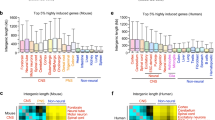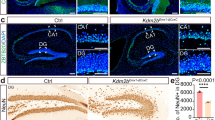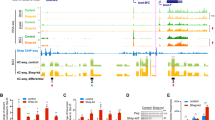Abstract
Genomic studies demonstrate that, although the majority of the mammalian genome is transcribed, only about 2% of these transcripts are code for proteins. We investigated how the long, polyadenylated Evf2 noncoding RNA regulates transcription of the homeodomain transcription factors DLX5 and DLX6 in the developing mouse forebrain. We found that, in developing ventral forebrain, Evf2 recruited DLX and MECP2 transcription factors to important DNA regulatory elements in the Dlx5/6 intergenic region and controlled Dlx5, Dlx6 and Gad1 expression through trans and cis-acting mechanisms. Evf2 mouse mutants had reduced numbers of GABAergic interneurons in early postnatal hippocampus and dentate gyrus. Although the numbers of GABAergic interneurons and Gad1 RNA levels returned to normal in Evf2 mutant adult hippocampus, reduced synaptic inhibition occurred. These results suggest that noncoding RNA–dependent balanced gene regulation in embryonic brain is critical for proper formation of GABA-dependent neuronal circuitry in adult brain.
This is a preview of subscription content, access via your institution
Access options
Subscribe to this journal
Receive 12 print issues and online access
$209.00 per year
only $17.42 per issue
Buy this article
- Purchase on Springer Link
- Instant access to full article PDF
Prices may be subject to local taxes which are calculated during checkout






Similar content being viewed by others
References
Prasanth, K.V. & Spector, D.L. Eukaryotic regulatory RNAs: an answer to the 'genome complexity' conundrum. Genes Dev. 21, 11–42 (2007).
Mattick, J.S. A new paradigm for developmental biology. J. Exp. Biol. 210, 1526–1547 (2007).
Shamovsky, I. & Nudler, E. Gene control by large noncoding RNAs. Sci. STKE 2006, pe40 (2006).
Feng, J. et al. The Evf-2 noncoding RNA is transcribed from the Dlx-5/6 ultraconserved region and functions as a Dlx-2 transcriptional coactivator. Genes Dev. 20, 1470–1484 (2006).
Zerucha, T. et al. A highly conserved enhancer in the Dlx5/Dlx6 intergenic region is the site of cross-regulatory interactions between Dlx genes in the embryonic forebrain. J. Neurosci. 20, 709–721 (2000).
Gilligan, P., Brenner, S. & Venkatesh, B. Fugu and human sequence comparison identifies novel human genes and conserved non-coding sequences. Gene 294, 35–44 (2002).
Santini, S., Boore, J.L. & Meyer, A. Evolutionary conservation of regulatory elements in vertebrate Hox gene clusters. Genome Res. 13, 1111–1122 (2003).
Bejerano, G. et al. Ultraconserved elements in the human genome. Science 304, 1321–1325 (2004).
Mercer, T.R., Dinger, M.E., Sunkin, S.M., Mehler, M.F. & Mattick, J.S. Specific expression of long noncoding RNAs in the mouse brain. Proc. Natl. Acad. Sci. USA 105, 716–721 (2008).
Di Cristo, G. Development of cortical GABAergic circuits and its implications for neurodevelopmental disorders. Clin. Genet. 72, 1–8 (2007).
Bienvenu, T. & Chelly, J. Molecular genetics of Rett syndrome: when DNA methylation goes unrecognized. Nat. Rev. Genet. 7, 415–426 (2006).
Moretti, P. & Zoghbi, H.Y. MeCP2 dysfunction in Rett syndrome and related disorders. Curr. Opin. Genet. Dev. 16, 276–281 (2006).
Chahrour, M. & Zoghbi, H.Y. The story of Rett syndrome: from clinic to neurobiology. Neuron 56, 422–437 (2007).
Dani, V.S. et al. Reduced cortical activity due to a shift in the balance between excitation and inhibition in a mouse model of Rett syndrome. Proc. Natl. Acad. Sci. USA 102, 12560–12565 (2005).
Lewis, D.A., Hashimoto, T. & Volk, D.W. Cortical inhibitory neurons and schizophrenia. Nat. Rev. Neurosci. 6, 312–324 (2005).
Soriano, P. Generalized lacZ expression with the ROSA26 Cre reporter strain. Nat. Genet. 21, 70–71 (1999).
Zhou, Q.P. et al. Identification of a direct Dlx homeodomain target in the developing mouse forebrain and retina by optimization of chromatin immunoprecipitation. Nucleic Acids Res. 32, 884–892 (2004).
Panganiban, G., Sebring, A., Nagy, L. & Carroll, S. The development of crustacean limbs and the evolution of arthropods. Science 270, 1363–1366 (1995).
Kohtz, J.D., Baker, D.P., Corte, G. & Fishell, G. Regionalization within the mammalian telencephalon is mediated by changes in responsiveness to Sonic Hedgehog. Development 125, 5079–5089 (1998).
Kohtz, J.D. et al. N-terminal fatty-acylation of sonic hedgehog enhances the induction of rodent ventral forebrain neurons. Development 128, 2351–2363 (2001).
Feng, J. et al. Synergistic and antagonistic roles of the Sonic hedgehog N- and C-terminal lipids. Development 131, 4357–4370 (2004).
Anderson, S.A. et al. Mutations of the homeobox genes Dlx-1 and Dlx-2 disrupt the striatal subventricular zone and differentiation of late born striatal neurons. Neuron 19, 27–37 (1997).
Horike, S., Cai, S., Miyano, M., Cheng, J.F. & Kohwi-Shigematsu, T. Loss of silent-chromatin looping and impaired imprinting of DLX5 in Rett syndrome. Nat. Genet. 37, 31–40 (2005).
Nan, X., Campoy, F.J. & Bird, A. MeCP2 is a transcriptional repressor with abundant binding sites in genomic chromatin. Cell 88, 471–481 (1997).
Le, T.N. et al. Dlx homeobox genes promote cortical interneuron migration from the basal forebrain by direct repression of the semaphorin receptor neuropilin-2. J. Biol. Chem. 282, 19071–19081 (2007).
Kishi, N. & Macklis, J.D. MECP2 is progressively expressed in post-migratory neurons and is involved in neuronal maturation rather than cell fate decisions. Mol. Cell. Neurosci. 27, 306–321 (2004).
Panganiban, G. & Rubenstein, J.L. Developmental functions of the Distal-less/Dlx homeobox genes. Development 129, 4371–4386 (2002).
Anderson, S.A., Eisenstat, D.D., Shi, L. & Rubenstein, J.L. Interneuron migration from basal forebrain to neocortex: dependence on Dlx genes. Science 278, 474–476 (1997).
Pleasure, S.J. et al. Cell migration from the ganglionic eminences is required for the development of hippocampal GABAergic interneurons. Neuron 28, 727–740 (2000).
Marín, O. & Rubenstein, J.L. Cell migration in the forebrain. Annu. Rev. Neurosci. 26, 441–483 (2003).
Wichterle, H., Turnbull, D.H., Nery, S., Fishell, G. & Alvarez-Buylla, A. In utero fate mapping reveals distinct migratory pathways and fates of neurons born in the mammalian basal forebrain. Development 128, 3759–3771 (2001).
Cobos, I. et al. Mice lacking Dlx1 show subtype-specific loss of interneurons, reduced inhibition and epilepsy. Nat. Neurosci. 8, 1059–1068 (2005).
Potier, B., Jouvenceau, A., Epelbaum, J. & Dutar, P. Age-related alterations of GABAergic input to CA1 pyramidal neurons and its control by nicotinic acetylcholine receptors in rat hippocampus. Neuroscience 142, 187–201 (2006).
Xu, C., Cui, C. & Alkon, D.L. Age-dependent enhancement of inhibitory synaptic transmission in CA1 pyramidal neurons via GluR5 kainate receptors. Hippocampus (2009).
Sleutels, F., Zwart, R. & Barlow, D.P. The non-coding Air RNA is required for silencing autosomal imprinted genes. Nature 415, 810–813 (2002).
Stühmer, T., Anderson, S.A., Ekker, M. & Rubenstein, J.L. Ectopic expression of the Dlx genes induces glutamic acid decarboxylase and Dlx expression. Development 129, 245–252 (2002).
Chahrour, M. et al. MeCP2, a key contributor to neurological disease, activates and represses transcription. Science 320, 1224–1229 (2008).
Cowles, C.R., Hirschhorn, J.N., Altshuler, D. & Lander, E.S. Detection of regulatory variation in mouse genes. Nat. Genet. 32, 432–437 (2002).
Yan, H., Yuan, W., Velculescu, V.E., Vogelstein, B. & Kinzler, K.W. Allelic variation in human gene expression. Science 297, 1143 (2002).
Doss, S., Schadt, E.E., Drake, T.A. & Lusis, A.J. Cis-acting expression quantitative trait loci in mice. Genome Res. 15, 681–691 (2005).
Yelin, R. et al. Widespread occurrence of antisense transcription in the human genome. Nat. Biotechnol. 21, 379–386 (2003).
Mancini-DiNardo, D., Steele, S.J., Levorse, J.M., Ingram, R.S. & Tilghman, S.M. Elongation of the Kcnq1ot1 transcript is required for genomic imprinting of neighboring genes. Genes Dev. 20, 1268–1282 (2006).
Heng, J.I., Moonen, G. & Nguyen, L. Neurotransmitters regulate cell migration in the telencephalon. Eur. J. Neurosci. 26, 537–546 (2007).
Cuzon, V.C., Yeh, P.W., Cheng, Q. & Yeh, H.H. Ambient GABA promotes cortical entry of tangentially migrating cells derived from the medial ganglionic eminence. Cereb. Cortex 16, 1377–1388 (2006).
López-Bendito, G. et al. Blockade of GABA(B) receptors alters the tangential migration of cortical neurons. Cereb. Cortex 13, 932–942 (2003).
Guy, J., Gan, J., Selfridge, J., Cobb, S. & Bird, A. Reversal of neurological defects in a mouse model of Rett syndrome. Science 315, 1143–1147 (2007).
Giacometti, E., Luikenhuis, S., Beard, C. & Jaenisch, R. Partial rescue of MeCP2 deficiency by postnatal activation of MeCP2. Proc. Natl. Acad. Sci. USA 104, 1931–1936 (2007).
Schüle, B., Li, H.H., Fisch-Kohl, C., Purmann, C. & Francke, U. DLX5 and DLX6 expression is biallelic and not modulated by MeCP2 deficiency. Am. J. Hum. Genet. 81, 492–506 (2007).
Liu, P., Jenkins, N.A. & Copeland, N.G. A highly efficient recombineering-based method for generating conditional knockout mutations. Genome Res. 13, 476–484 (2003).
Chomczynski, P. & Sacchi, N. Single-step method of RNA isolation by acid guanidinium thiocyanate-phenol-chloroform extraction. Anal. Biochem. 162, 156–159 (1987).
Acknowledgements
We thank K. Campbell for providing early passage W4 embryonic stem cells, and training and guidance in ES cell manipulation, M. Ekker for Dlx5/6 BAC, P. Lui and N. Copeland for PL253, PL452, bacterial strains and protocols for BAC recombineering, G. Taborn and P. Iannaccone for blastocyst injections, D. Eisentstat for antibody specific to DLX2, A. Joyner for the triple polyadenylation construct, J. Rubenstein for Gad1 probe, and Q. Ma for v-Glut1 probe. We thank K. Jones (Northwestern University) for establishing the conditions for embryonic tissue ChIP. This work was funded by National Institute of Child Health and Human Development grants RO1 HD044745 and R21 HD049875, the Illinois Regenerative Medicine Institute, and an Illinois Excellence in Academic Medicine grant to J.D.K.
Author information
Authors and Affiliations
Contributions
A.M.B. performed the experiments in Figures 1,2,3,4,5. M.J.W.V. carried out BAC recombineering, ES cell homologous targeting and screening for generating Evf2 TS mice. J.C.S. performed the experiments shown in Figures 1, 3 and 5. M.F.C. carried out the experiments shown in Figures 1, 5 and Supplementary Figure 1. E.A.S. and J.F.D. contributed electrophysiology experiments and results for Figure 6. J.D.K. conceived of and directed experiments and wrote the manuscript.
Corresponding author
Supplementary information
Supplementary Text and Figures
Supplementary Figures 1–3 (PDF 339 kb)
Rights and permissions
About this article
Cite this article
Bond, A., VanGompel, M., Sametsky, E. et al. Balanced gene regulation by an embryonic brain ncRNA is critical for adult hippocampal GABA circuitry. Nat Neurosci 12, 1020–1027 (2009). https://doi.org/10.1038/nn.2371
Received:
Accepted:
Published:
Issue Date:
DOI: https://doi.org/10.1038/nn.2371
This article is cited by
-
Integrative analysis of long noncoding RNAs dysregulation and synapse-associated ceRNA regulatory axes in autism
Translational Psychiatry (2023)
-
Distinct gene expression patterns of SOX2 and SOX2OT variants in different types of brain tumours
Journal of Genetics (2023)
-
Non-Coding RNA-Mediated Gene Regulation in Cardiovascular Disorders: Current Insights and Future Directions
Journal of Cardiovascular Translational Research (2023)
-
Construction of a lncRNA-associated competing endogenous RNA regulatory network after traumatic brain injury in mouse
Molecular Brain (2022)
-
From genotype to phenotype: genetics of mammalian long non-coding RNAs in vivo
Nature Reviews Genetics (2022)



